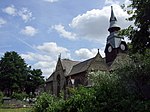Trinity Independent Chapel
Chapels in LondonChurches completed in 1951Churches in the London Borough of Tower HamletsCongregationalismFormer Methodist churches in the United Kingdom ... and 6 more
Grade II listed buildings in the London Borough of Tower HamletsGrade II listed churches in LondonGreek Revival church buildings in the United KingdomMethodist churches in LondonPoplar, LondonRenaissance Revival architecture in the United Kingdom

The Trinity Independent Chapel (also known as the Congregational or Methodist chapel) was an early Victorian church in Poplar. It was destroyed by a V-2 rocket hit during the Second World War, and later re-built in Modernist style. In the late 1990s the building was sold to the Calvary Charismatic Baptist Church, and since then has served as their Prayer Temple and international headquarters.
Excerpt from the Wikipedia article Trinity Independent Chapel (License: CC BY-SA 3.0, Authors, Images).Trinity Independent Chapel
East India Dock Road, London Poplar
Geographical coordinates (GPS) Address Website Nearby Places Show on map
Geographical coordinates (GPS)
| Latitude | Longitude |
|---|---|
| N 51.511388888889 ° | E -0.018888888888889 ° |
Address
Queen Victoria Seamen's Rest
East India Dock Road 121-131
E14 6DF London, Poplar
England, United Kingdom
Open on Google Maps








